Predictive analytics can help ensure you're sending the right kind of email messages to the right customers at the right time in order to improve results.
Using predictive analytics to power up email marketing is nothing new, but it is becoming increasingly popular these days - particularly for e-commerce businesses. The reason for this is that predictive analytics help companies make smarter and faster decisions.
Check out the below graph of how predictive analytics, along with AI, help companies in different ways:
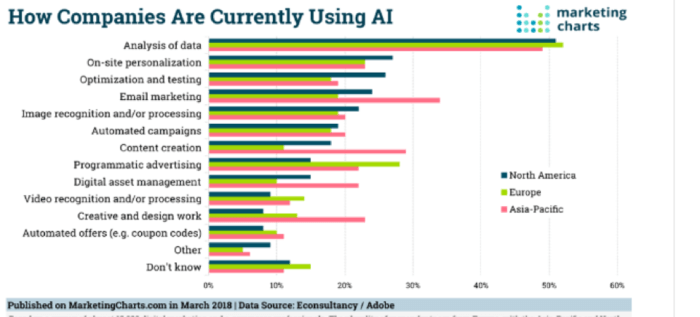
It's no surprise that email marketing features in this list as it is 40% more effective in acquiring new customers than Twitter and Facebook combined.
If you want to market smarter, predictive analysis is the way. Here's how it can power up your email marketing strategy:
Activation or acquisition
Whether you want to send a welcome email, discount code, or coupon to your customers, segment customers, using A/B testing to figure out if an email is more compatible with sales, etc. it can require a lot of time and work. But with predictive analytics, all these mundane tasks can be simplified. This type of analytics helps online sellers segment customers into particular groups and constructs a model on the basis of what is learned.
However, if you carry out this work yourself, it can take a lot of time, and - as your customer's data will require updating in real-time - it can be challenging to group your customers by yourself. For instance, existing and new customers will require different services and support. You shouldn't the same email to your new customer and to your loyal customers, as it won't have the same results and could impact brand advocacy.
With the help of predictive analytics, you will know which data works best for which group, helping you create the best combination of promotion and welcome emails. The usage of data to market your service, also called data-driven marketing, is executed through predictive analytics, along with others like data visualization, automated personalization, CRM, etc.
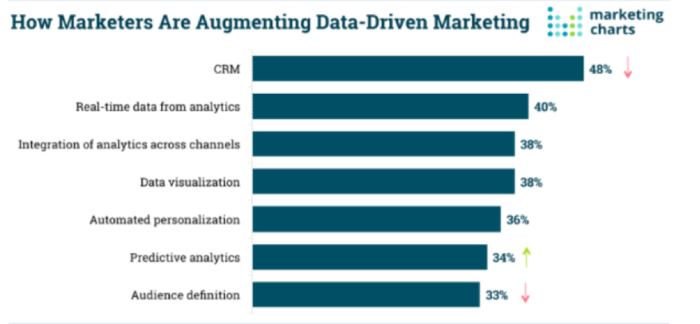
It can help in growing your first sales order by up to three times and amplify your conversion rates.
In a survey undertaken by Smart Insights, marketers were asked what will contribute the largest impact on businesses in 2018. A majority of 28% chose activities related to predictive marketing, which you can see in the below graph, big data making 14% and AI, making a 14% impact on the business.
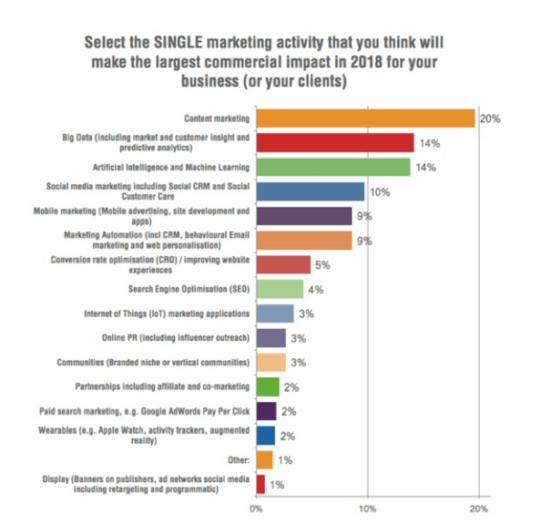
Understand and motivate your customers
After your customers subscribe to your email list, you have to drive them to make their first purchase on your site. However, being too pushy will turn off your customers and make them less likely to purchase. So, what you can do is send them a welcome email first, and with the help of predictive analytics, you can find out what it is that they are looking for.
Check the below welcome email send by the BBC:
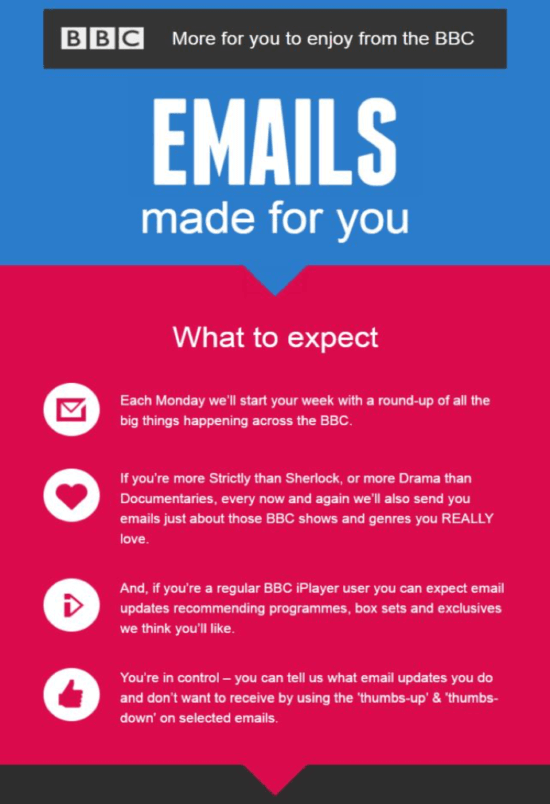
The email welcomes the new subscriber, providing information on what to expect if the subscriber is using BBC iPlayer, or if they love drama and documentaries, among other aspects.
In this way, you can even send an email requesting that your customers provide suggestions on what content or products they may be interested in. This way, your customers automatically segment themselves and provide you with their preferences for targeting. Not just that, but with the predictive analytics, you can get to grips with what piques the interests of your customers and what area of the email they will click.
You can utilize the data derived from predictive analytics on the welcome email to send your customer’s a targeted email later on. There is a high chance that your email subscribers will commit to a purchase if you present them with exactly what they are looking for. So, use predictive analytics to your advantage.
Upsell and Cross-sell
If you successfully convert an email subscriber into your customer, you can effectively utilize predictive analytics to up and cross-sell to your customers and increase your conversions. By monitoring the items your customer's purchase, you can further utilize that data for recommending similar items they're more likely to purchase.
For example, if your customer bought a sweater from your website, you could then send them an email announcing a sale on similar products. However, you should only send these emails after proper analysis because it is found that 50% of customers will immediately leave the site if they are shown a recommendation that they dislike or are unlikely to purchase.
Thanks to predictive analytics, you'll be one step ahead of your customer's needs, and you'll be able to provide them with what they need even before they can think about it. It's a fantastic way of keeping them interested.
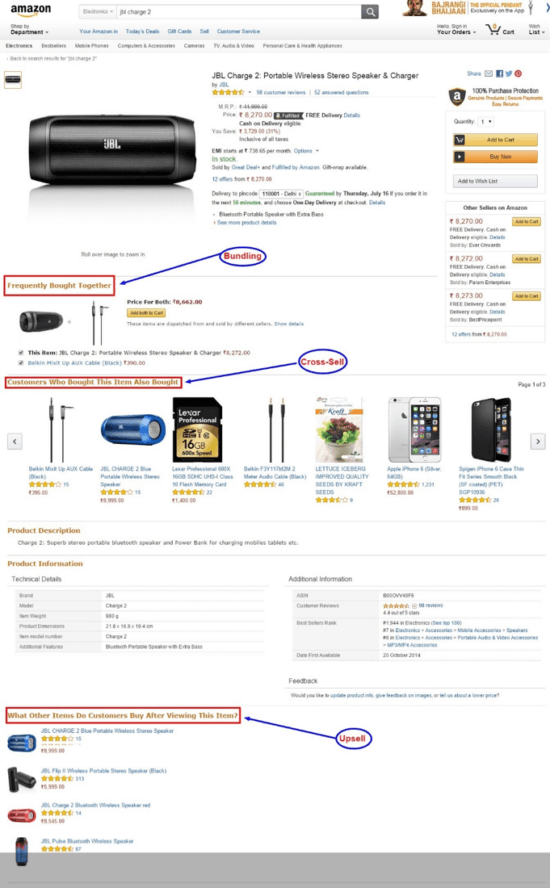
Keeping up with your customers
With the aid of predictive analytics, you can always keep your customers interested. If they are happy with your service and business, they'll probably purchase from you often. In fact, data shows that millennials spend 21% more when they get a better customer experience. So, ensure that you cleverly utilize predictive analytics to encourage your customers to buy more by continually updating yourself with their interests and customizing your emails for them.
For instance, if your customers make a purchase only during sales or events, don’t bombard them with emails about full-priced expensive products but opt to send emails about discounts and deals that they'll love to know about.
Check the below example of an email send by Topshop, a UK-based fashion retailer:
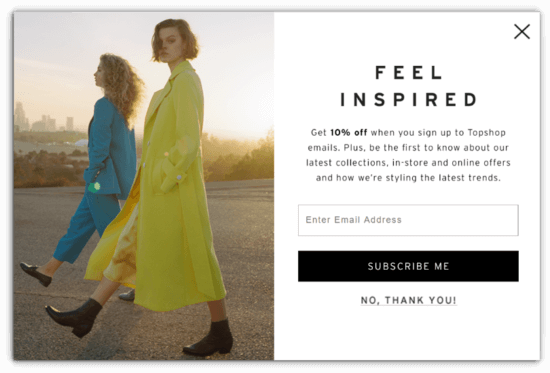
This is another example from Topshop, placed strategically on the footer for better view.
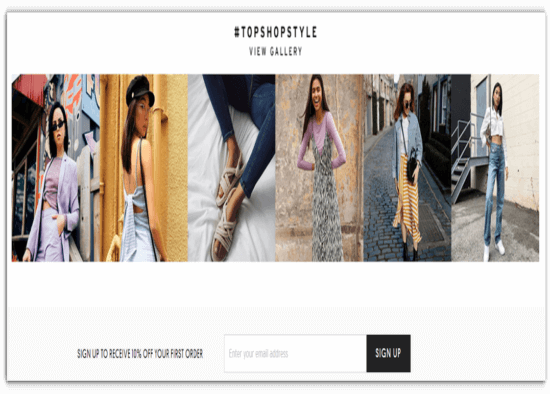
The email has exclusive content and discounts for the recipient. With predictive analytics, you can also elevate your customer care to the next level. For instance, if you notice that your customer buys a particular product every single month, you can customize emails, reminding them to restock their favourite products.
Retain your customers
If you run an e-commerce business, losing a customer can be a huge deal, especially as attracting new customers is five times more expensive than retaining the ones you already have. But thanks to predictive analytics, you can prevent your beloved customers from walking out on you. Build customer loyalty and carry out “we miss you” campaigns so that you don’t lose any of your existing customers.
This strategy is popular with SaaS businesses and apps, but any company can leverage this technique, including e-commerce. With data, you can check out the last time your customer used your service or product or visited your website. Later on, you can send them emails, encouraging them to return.
Not just that, but as an e-commerce business, you can effectively utilize predictive analytics to understand your customers buying patterns. If you had a customer that made a purchase every single week and suddenly stopped, you could send them 'we miss you' emails to reel them back in. It's recommended that you offer them a humble discount to motivate them to return. Additionally, to retain your frequent buyers, offer them exclusive VIP discounts.
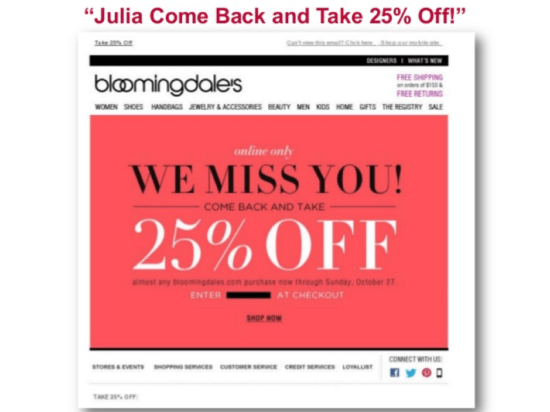
Verdict
Data is power, so make sure that you effectively use it to power up your business. With the help of predictive analytics, you can scale up your email marketing techniques and impress your customers and subscribers and convert them into lifelong customers, which in turn will dramatically increase your sales.
Clara Beck is a Business Manager with 8 years of experience at
Thomson Data based out of Plano, Texas. She helps SMBs and Enterprise firms take full advantage of the latest marketing tools to scale up their business. She blogs about Small businesses, Marketing, CX, Entrepreneurship, Big Data and, other technological innovations. Connect with Clara on
LinkedIn and
Twitter learn how to win more leads.














